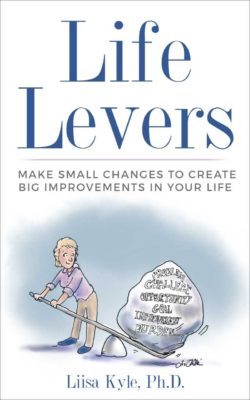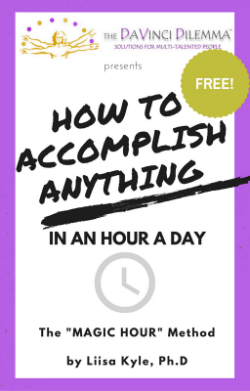DaVincis make the very best procrastinators. Not only do we have all the regular tools at our disposal, such as common distractions — we even distract ourselves.We’re always thinking of new ideas that pull us away from our focus. When the thing we were focusing on is something that makes us uncomfortable — such as a blank page, any other thought seems fascinating and urgent.
The other way that creative people fool themselves into getting nothing meaningful done in a day, is to do a lot of meaningless activity that only seems meaningful at the time. It may even appear to be efficient and productive. You don’t feel like a procrastinator, which you think looks like someone lying on the sofa watching Dr. Phil and eating granola out of the box, because you’re busy all day long. This video, done by someone who is obviously both very creative and intimately familiar with procrastination, says it all:
How to Stay On Track
Being active and being productive are not the same. Here’s how to keep from getting sucked into the maelstrom of seemingly important but ultimately meaningless activity and start getting something done that matters to you.
- Decide what you will do first. Setting your intention first thing in the morning, or even the night before, is essential if procrastination or lack of focus is an issue for you. Write it down. It will become apparent on paper if you are being realistic or biting off too much — which leads to overwhelm, a major cause of procrastination. Whittle your intention down to something do-able.
- Get started. What you start on is also crucial. If you check you email first thing every day, “just to get it out of the way” you are a goner . Ditto for telephone calls (whether made or answered — that’s what voice mail is for), newspapers (will knowing about a fire, sex scandal or car crash in a place you’ve never heard of really help you with your project?) and snail mail. In fact, any “innocent” puttering is just asking for trouble. If you must do things before you get started (make coffee, walk the dog, perform similar functions yourself) set a time to get started on your intention, say at the top of the hour, and then start. In The Now Habit, a fabulous book for people struggling with procrastination, Neil Fiore talks not about working on or finishing a project, which can feel like drudgery, but about constantly starting. When is the next time you can start?
- Do Nothing Else. Fiore suggests aiming for 30 minutes of uninterrupted quality work. To me, this means not only that you do what you started, but that you don’t do anything else. That means no hopping over to Twitter while your screenwriting program is loading, no getting up for coffee, no playing with pets, no checking to see what your stocks would be doing if you owned stocks. NOTE: This includes “time savers” that don’t directly impact your “getting your stuff done”. Running a bunch of errands that take all afternoon because you were in the neighborhood and wanted to to save an extra trip does NOT actually add any time to the time available to work on your project, it just delays your arrival at your desk, easel or other place of work. (Sorry, you’re busted.) Preparation such as rearranging your desk, gathering provisions, or even getting a good night’s sleep (sleep is a great procrastination tool) also does not count as being productive.
- Take a well earned — and well defined — break. After each period of 30 minutes, Fiore advises giving yourself credit, and allowing yourself a break, which could be a more enjoyable activity. But don’t let your break stretch out over the rest of your day. Set a kitchen timer if it helps. (It does.) Decide how long you will rest, and be sure you always have your eye on the next time you can “start”.
When you first set your intention, guard your attention, keep on “starting” and reward yourself for short stretches of uninterrupted work on your project, you’ll be doing activity that actually gets you somewhere, one solid chunk at at time.
Activity: Choose a project you’d like to make progress on. Set a realistic intention for how much you will do, and decide exactly when you will start. Also choose one or two activities you can do on short breaks.
What sorts of activities have you used to procrastinate? Feel free to ‘fess up below.
*****
If you’d like to share or publish this article, you may, if you include the author’s name, a link to this original post and the following text blurb:
Are you struggling with too many talents, skills, ideas? You may have The Da Vinci Dilemma™! Find tools, fun quizzes, coaching, inspiration and solutions for multi-talented people at http://www.davincidilemma.com/.



